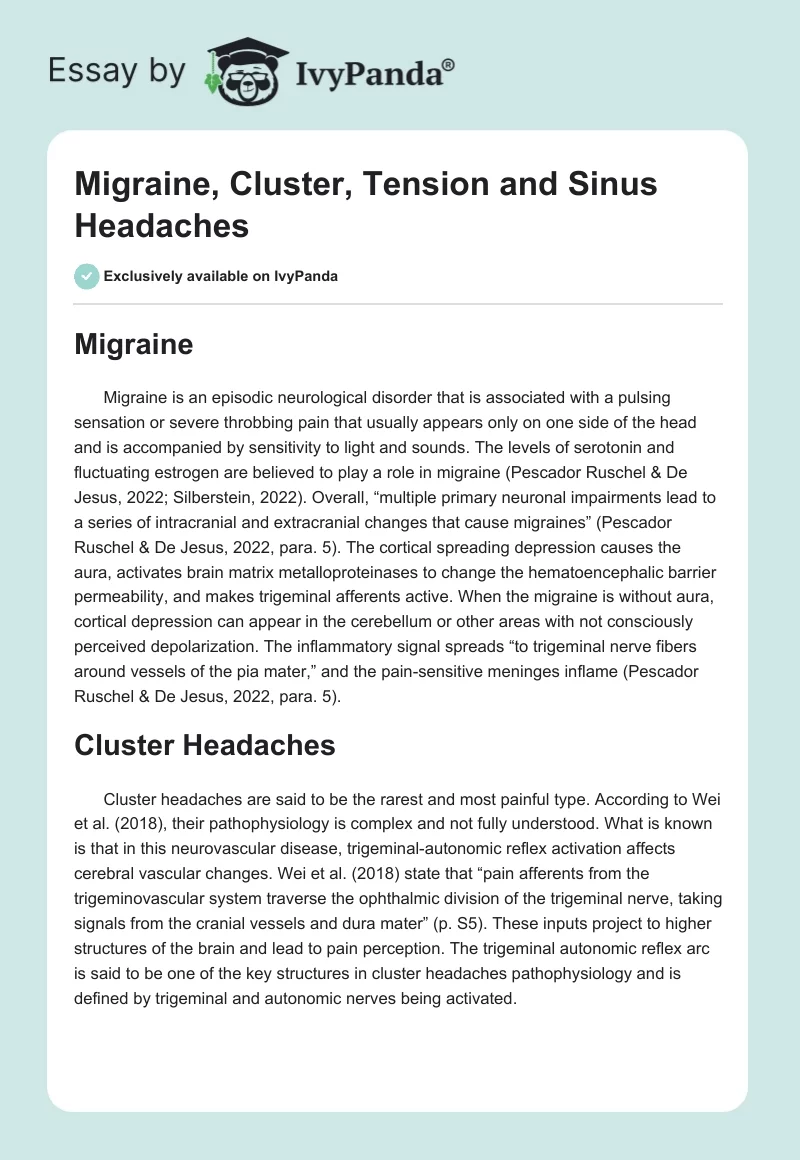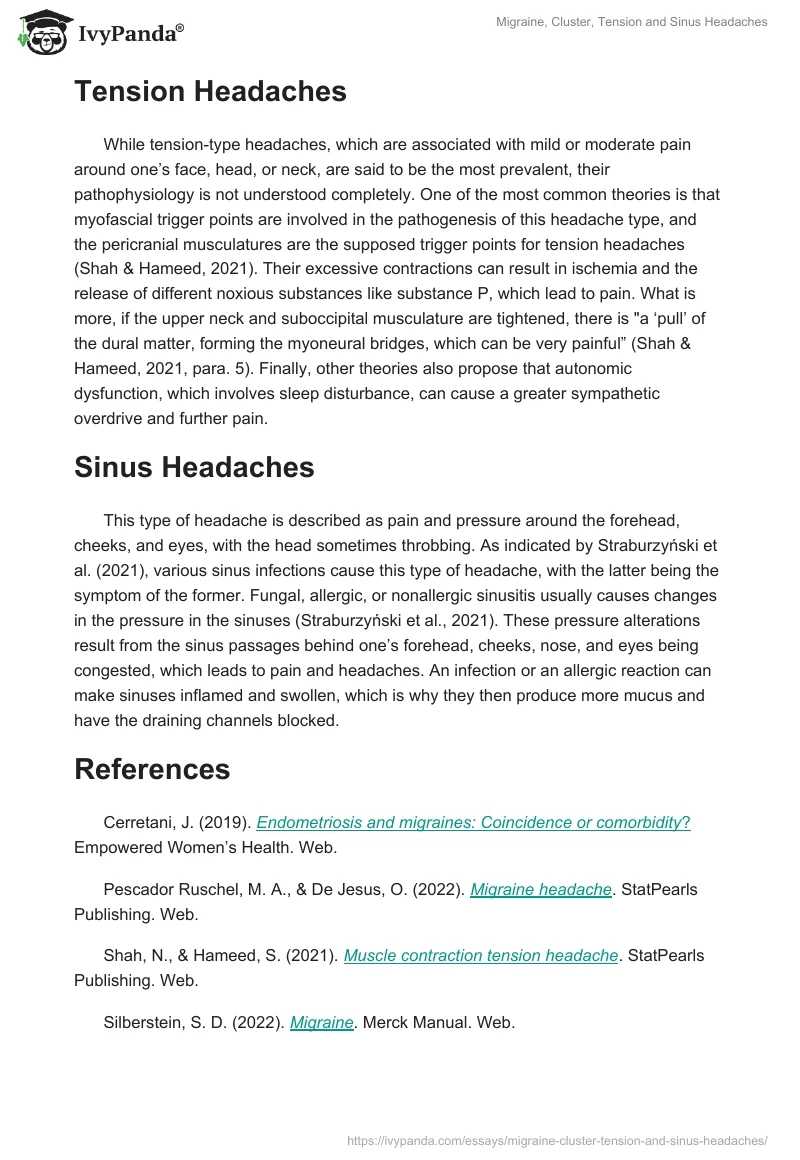Migraine
Migraine is an episodic neurological disorder that is associated with a pulsing sensation or severe throbbing pain that usually appears only on one side of the head and is accompanied by sensitivity to light and sounds. The levels of serotonin and fluctuating estrogen are believed to play a role in migraine (Pescador Ruschel & De Jesus, 2022; Silberstein, 2022). Overall, “multiple primary neuronal impairments lead to a series of intracranial and extracranial changes that cause migraines” (Pescador Ruschel & De Jesus, 2022, para. 5). The cortical spreading depression causes the aura, activates brain matrix metalloproteinases to change the hematoencephalic barrier permeability, and makes trigeminal afferents active. When the migraine is without aura, cortical depression can appear in the cerebellum or other areas with not consciously perceived depolarization. The inflammatory signal spreads “to trigeminal nerve fibers around vessels of the pia mater,” and the pain-sensitive meninges inflame (Pescador Ruschel & De Jesus, 2022, para. 5).
Cluster Headaches
Cluster headaches are said to be the rarest and most painful type. According to Wei et al. (2018), their pathophysiology is complex and not fully understood. What is known is that in this neurovascular disease, trigeminal-autonomic reflex activation affects cerebral vascular changes. Wei et al. (2018) state that “pain afferents from the trigeminovascular system traverse the ophthalmic division of the trigeminal nerve, taking signals from the cranial vessels and dura mater” (p. S5). These inputs project to higher structures of the brain and lead to pain perception. The trigeminal autonomic reflex arc is said to be one of the key structures in cluster headaches pathophysiology and is defined by trigeminal and autonomic nerves being activated.
Tension Headaches
While tension-type headaches, which are associated with mild or moderate pain around one’s face, head, or neck, are said to be the most prevalent, their pathophysiology is not understood completely. One of the most common theories is that myofascial trigger points are involved in the pathogenesis of this headache type, and the pericranial musculatures are the supposed trigger points for tension headaches (Shah & Hameed, 2021). Their excessive contractions can result in ischemia and the release of different noxious substances like substance P, which lead to pain. What is more, if the upper neck and suboccipital musculature are tightened, there is “a ‘pull’ of the dural matter, forming the myoneural bridges, which can be very painful” (Shah & Hameed, 2021, para. 5). Finally, other theories also propose that autonomic dysfunction, which involves sleep disturbance, can cause a greater sympathetic overdrive and further pain.
Sinus Headaches
This type of headache is described as pain and pressure around the forehead, cheeks, and eyes, with the head sometimes throbbing. As indicated by Straburzyński et al. (2021), various sinus infections cause this type of headache, with the latter being the symptom of the former. Fungal, allergic, or nonallergic sinusitis usually causes changes in the pressure in the sinuses (Straburzyński et al., 2021). These pressure alterations result from the sinus passages behind one’s forehead, cheeks, nose, and eyes being congested, which leads to pain and headaches. An infection or an allergic reaction can make sinuses inflamed and swollen, which is why they then produce more mucus and have the draining channels blocked.
References
Cerretani, J. (2019). Endometriosis and migraines: Coincidence or comorbidity? Empowered Women’s Health. Web.
Pescador Ruschel, M. A., & De Jesus, O. (2022). Migraine headache. StatPearls Publishing. Web.
Shah, N., & Hameed, S. (2021). Muscle contraction tension headache. StatPearls Publishing. Web.
Silberstein, S. D. (2022). Migraine. Merck Manual. Web.
Straburzyński, M., Gryglas-Dworak, A., Nowaczewska, M., Brożek-Mądry, E., & Martelletti, P. (2021). Etiology of ‘sinus headache’-moving the focus from rhinology to neurology. A systematic review. Brain Sciences, 11(1). Web.
Wei, D. Y., Yuan Ong, J. J., & Goadsby, P. J. (2018). Cluster headache: Epidemiology, pathophysiology, clinical features, and diagnosis. Annals of Indian Academy of Neurology, 21(Suppl 1), S3–S8. Web.
Wu, Y., Wang, H., Chen, S., Lin, Y., Xie, X., Zhong, G., & Zhang, Q. (2021). Migraine is more prevalent in advanced-stage endometriosis, especially when co-occuring with adenomyosis. Frontiers in Endocrinology, 12. Web.


